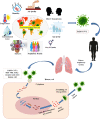Current understanding of the influence of environmental factors on SARS-CoV-2 transmission, persistence, and infectivity
- PMID: 33387315
- PMCID: PMC7776306
- DOI: 10.1007/s11356-020-12165-1
Current understanding of the influence of environmental factors on SARS-CoV-2 transmission, persistence, and infectivity
Abstract
Coronavirus disease 2019 (COVID-19) has emerged as a significant public health emergency in recent times. It is a respiratory illness caused by the novel virus, severe acute respiratory syndrome coronavirus 2 (SARS-CoV-2), which was initially reported in late December 2019. In a span of 6 months, this pandemic spread across the globe leading to high morbidity and mortality rates. Soon after the identification of the causative virus, questions concerning the impact of environmental factors on the dissemination and transmission of the virus, its persistence in environmental matrices, and infectivity potential begin to emerge. As the environmental factors could have far-reaching consequences on infection dissemination and severity, it is essential to understand the linkage between these factors and the COVID-19 outbreak. In order to improve our current understanding over this topic, the present article summarizes topical and substantial observations made regarding the influences of abiotic environmental factors such as climate, temperature, humidity, wind speed, air, and water quality, solid surfaces/interfaces, frozen food, and biotic factors like age, sex, gender, blood type, population density, behavioural characteristics, etc. on the transmission, persistence, and infectivity of this newly recognized SARS-CoV-2 virus. Further, the potential pathways of virus transmission that could pose risk to population health have been discussed, and the critical areas have been identified which merits urgent research for the assessment and management of the COVID-19 outbreak. Where possible, the knowledge gaps requiring further investigation have been highlighted.
Keywords: COVID-19; Cold chain transportation; Environmental factors; Infectivity; Persistence; SARS-CoV-2; Transmission.
Conflict of interest statement
The authors declare that they have no competing interests.
Figures
References
-
- “COVID-19 weekly surveillance report” (2020) Data for the week of 22 - 28 Jun 2020 (Epi week 26) www.euro.who.int.https://www.euro.who.int/en/healthtopics/healthemergencies/coronavirusco.... Accessed on 5th July 2020
-
- Ahmed W, Angel N, Edson J, Bibby K, Bivins A, O'Brien JW, Tscharke B. First confirmed detection of SARS-CoV-2 in untreated wastewater in Australia: a proof of concept for the wastewater surveillance of COVID-19 in the community. Sci Total Environ. 2020;728:138764. doi: 10.1016/j.scitotenv.2020.138764. - DOI - PMC - PubMed
-
- Araujo MB, Naimi B (2020) Spread of SARS-CoV-2 Coronavirus likely to be constrained by climate. medRxiv. 10.1101/2020.03.12.20034728
Publication types
MeSH terms
Substances
LinkOut - more resources
Full Text Sources
Other Literature Sources
Medical
Research Materials
Miscellaneous




